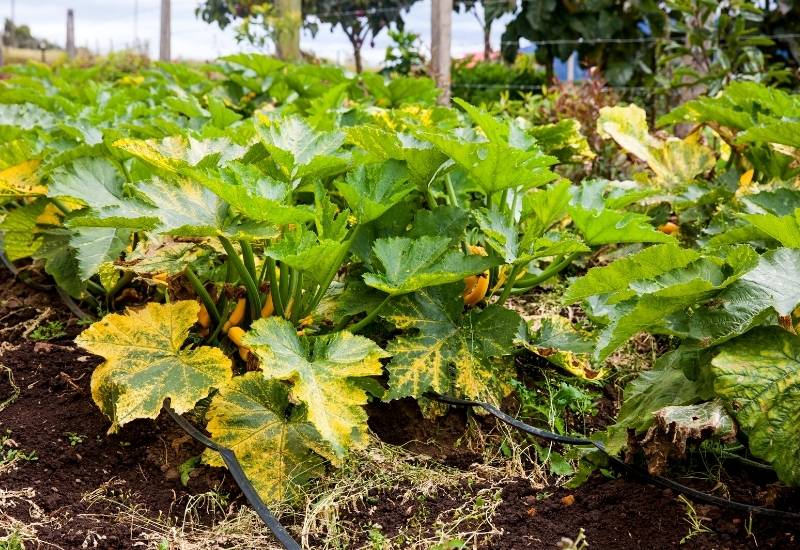
Zucchinis are an easy plant to grow in most climates. Sometimes, however, the typically dark green leaves will turn yellow and start dying. This is a clear indication that something is wrong with your plant.
A healthy zucchini plant will create chlorophyll, which is what makes the leaves the rich green color. When the leaves turn yellow, something is interfering with chlorophyll production, and this is a clear indication that something is wrong with your plant.
A zucchini leaf can turn yellow from nutrient and soil imbalances, too much or too little water, damaged roots, lack of sunlight, and several diseases and pests.
Many of these issues can mean a lost harvest or the death of your zucchini plant, so it is important to be able to properly identify the possible causes of yellow zucchini leaves and know how to fix it.
Why Are My Zucchini Leaves Turning Yellow?
While yellow leaves on zucchini plants can be caused by a number of factors, I’ve found these six issues are the most common.
Here are six possible reasons for your zucchini leaves turning yellow and what to do about each one:
1: It Isn’t Getting Enough Sunlight
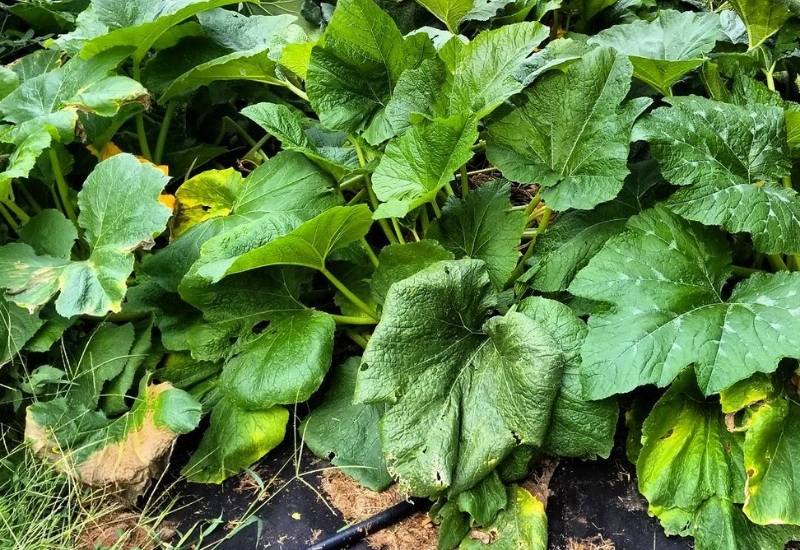
As the fall sun wanes, a zucchini plant will start going dormant and the leaves will turn yellow. This is a natural progression and should be allowed to takes its course.
During the growing season, however, any sign of yellowing leaves could indicate that the zucchini plant is not getting enough sun.
Zucchinis require full sun, which means at least 6 to 8 hours of direct sunlight each day (and more is even better). If your zucchini patch is too shaded, this could be the cause of your yellowing leaves.
Solution:
Unfortunately, if your zucchinis are planted in a shady spot in the garden, there isn’t much you can do about it except dig up the plants and move them. (Be careful not to damage the roots as we will discuss below.)
If your zucchinis are growing in pots, move the pot to a sunnier location. Zucchinis in the greenhouse might benefit from some artificial lighting.
2: Overwatering Or Underwatering
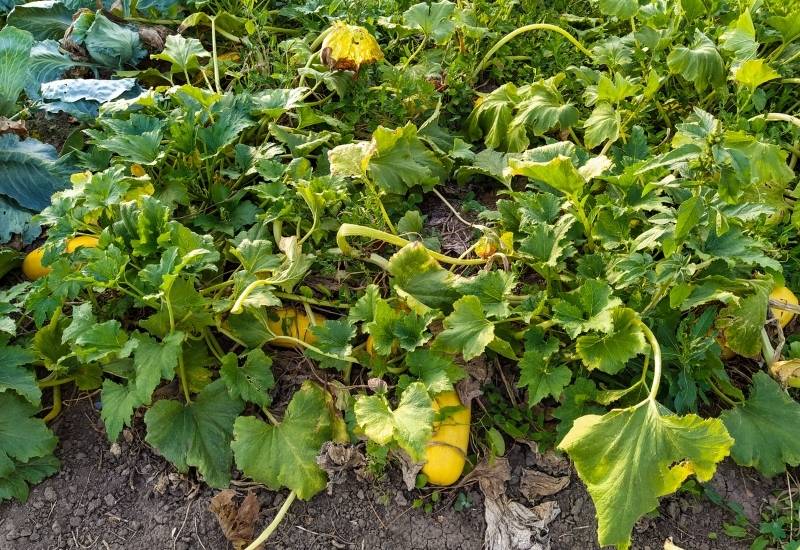
One of the most common reason that zucchini plant’s leaves turn yellow is because of Too much water or too little water, In the case of yellowing leaves, overwatering can be just as much to blame as underwatering.
Here’s how to tell the difference and treat each one.
Overwatering
All plants need water to survive, and zucchinis are no exception. However, zucchinis do not need very much water to grow and thrive.
If you overwater your zucchinis, the drowned roots will become stunted and won’t be able to properly support the plant.
Since the roots cannot give the plant what it needs, the leaves won’t be able to properly manufacture chlorophyll and they will start to turn yellow.
Pay particular attention to how much water you give your zucchinis when they are growing in heavy, clay soil.
Clay soils are especially susceptible to overwatering, as the tightly packed soil particles trap water and excess water cannot drain away.
Solution:
If your ground is saturated, the first thing to do is wait until the soil dries out. Once the soil has dried out enough, you can begin watering again in moderation. A zucchini plant will only need about 2 cm to 3 cm (1 inch) of water each week.
An easy way to tell if your zucchinis are getting enough water is to stick your finger into the soil to see how moist it is. If the top 2 cm to 5 cm (1 to 2 inches) is dry, it is time to give them some water. If it is still damp, check again in a day or so.
If you have clay soil, adding compost before planting and as a mulch throughout the growing season will really help to loosen that heavily compacted soil and allow excess water to drain away.
Underwatering
Not getting enough water can also cause zucchini leaves to yellow. When the zucchinis roots take on water, they also absorb nutrients from the soil to feed the plant (and produce chlorophyll).
If there is no water, there is no plant food to make the chlorophyll and the leaves will start to turn yellow.
Sandy soil can be your enemy here, as water will easily wash away through the loose soil particles. If you are growing zucchinis in sandy soil, make sure you check your soil regularly to make sure it isn’t drying out.
Solution:
To rectify this, simply start watering your zucchinis. Again, water in moderation following the guidelines mentioned above.
Dumping tons of water on your dehydrated zucchinis will either cause most of the water to wash away or will lead to overwatering.
Remember, consistent watering is best.
To help your sandy soil retain water, compost is again the solution. Adding compost to sandy soil will add humus and help bind the sandy soil together. Both of these will help with water retention and you won’t lose as much water to runoff.
3: Damaged Roots Can Cause Yellowing Leaves
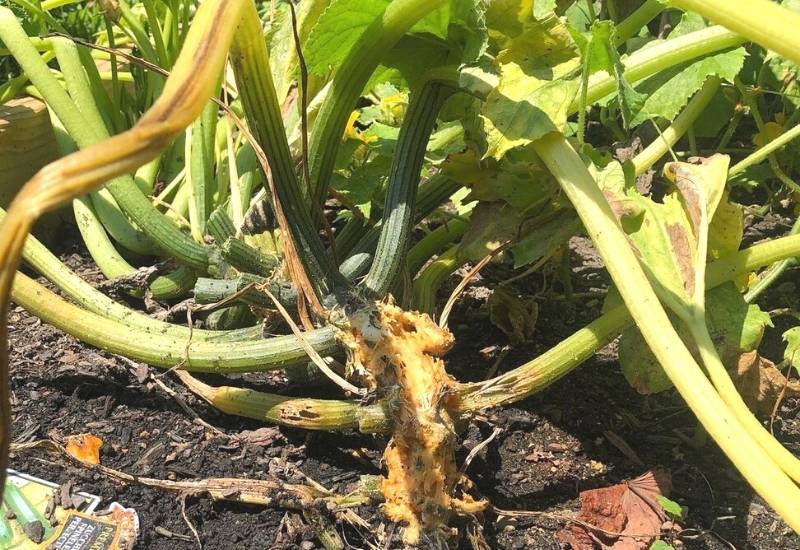
Maybe you recently moved your zucchini plant to a new location, but now the leaves have turned yellow. Or maybe you cultivated beside the plant and now the leaves are yellow and wilting.
If this is the case, you might have damaged the roots of your zucchini plants. Once the roots are damaged, they won’t be able to supply all the food and energy the plant needs to sustain good, healthy growth. As a result, some of the leaves start dying off.
Solution:
Unfortunately, there isn’t much you can do about this. Remove any yellow leaves that are dying to keep them from rotting and admitting disease, and try and avoid further stressing the plant.
Also, make sure the zucchini has adequate water so the undamaged roots do not have to work so hard.
4: Nutrient And Soil Deficiencies That Cause Zucchini Leaves To Turn Yellow
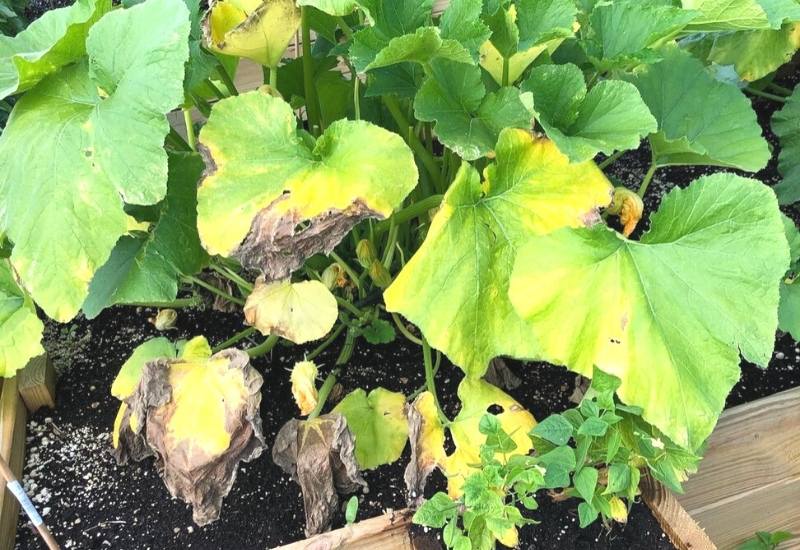
Iron is a key element in chlorophyll production. A zucchini plant will only need a small amount of iron to produce healthy, green leaves, but there are a number of reasons why your plant cannot get enough.
Firstly, your soil might be depleted in iron. But a far more likely dilemma is that the iron in your soil is trapped and cannot be accessed by the roots.
An excess of calcium, manganese, phosphorous, copper, potassium, or zinc, can all lead to the iron being bound in the soil and not accessible to the plant.
Insufficient nitrogen can also be a culprit in yellowing zucchini leaves. Nitrogen is essential for healthy stem and leaf growth so it is important to make sure your zucchinis are getting enough.
Also, check your soil’s pH levels. Zucchinis prefer a soil pH of 6.5 and 7.0. If the soil is more alkaline, it can lead to yellow leaves.
How to Prevent Nutrient Deficiencies
The first step to combating nutrient imbalances is to have a sample of your soil tested. That way, you know exactly what you are dealing with, and what to add.
While adding fertilizer is the first thing most people think of to fix a nutrient imbalance, this can possibly aggravate the issue and cause further yellowing of the leaves.
Most fertilizers sold for vegetables will be too high in phosphorous and potassium and can cause, or worsen, an iron deficiency.
As with most things in the garden, your yellowing zucchini leaves can be rectified by compost or well-rotted manure. These soil amendments will not only provide valuable plant food, but they will help regulate imbalanced nutrients.
Cow manure is not ideal if you are battling iron deficiencies in your zucchinis as it is too high in phosphorous, but adding well-rotted chicken or horse manure will provide valuable nitrogen.
Compost will also help regulate the pH level if your soil is too alkaline.
5: Has Been Infected With A Fungal Or Viral Disease

While there are many diseases that can infect your zucchinis, there are three main viruses and fungi that will cause the leaves to turn yellow.
When dealing with diseases, it is important to properly dispose of the plants and NEVER put any diseased plant matter in your compost.
Identify And Control 3 Common Zucchini Plant Diseases
Cucumber Mosaic Virus
This virus attacks all members of the cucurbits family, including your zucchini. This virus will cause splotchy yellow leaves, and the stunted fruits will also have yellow splotches.
Fusarium Wilt
This fungus causes leaves to yellow and is spread by the cucumber beetle. Its spores can also survive over winter and infect your zucchinis the following year.
Downy Mildew
Downy mildew survives in the damp and the cool. Besides the spotty yellow leaves, it can be identified by the fuzzy-looking fungus on the underside of the leaves. The spores are usually spread by the wind and can survive for years in the soil.
6: Insect “Pests”
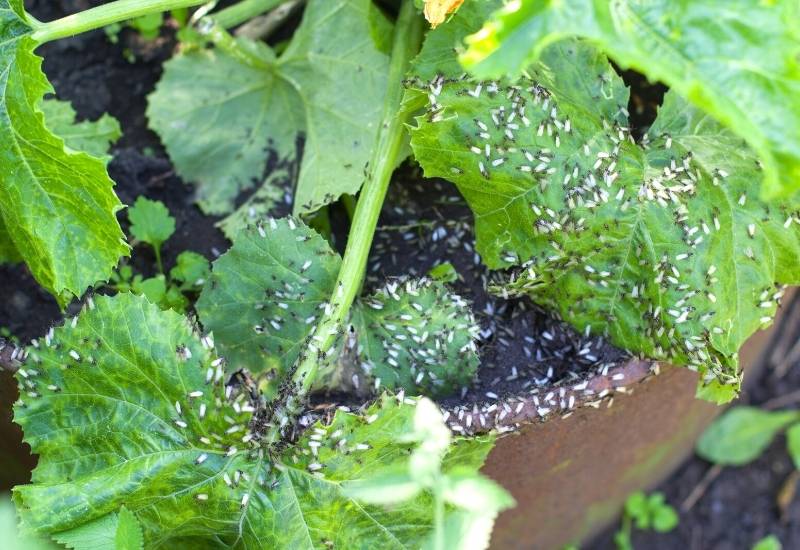
There are many bugs that live on your zucchini plants, but some of them cause more harm than good.
Here are some of the “bad” bugs that can cause your zucchini leaves to turn yellow.
Aphids
Not only do they spread the cucumber mosaic virus, but aphids also eat sap from the plant and drain nutrients from the leaves. You can tell if aphids are causing your zucchini leaves to turn yellow by the black, sticky residue they leave behind.
Spider Mites
Like aphids, spider mites will turn the leaves yellow by sucking the sap. Spider mites leave their tell-tale webs on the leaves.
Squash Bugs
These bugs also drink the sap and leave behind yellow spots that usually fade to brown. They can do a significant amount of damage by reducing yield or killing off young zucchini plants altogether.
Squash Vine Borers
As their name suggests, these rather large bugs eat their way inside the plant, causing the leaves to turn yellow and many of the plants to die. These bugs are best removed by hand.
Solution:
Once your leaves turn yellow, and you identify these bugs, it is time to remove them from the garden to protect your zucchinis. The best way to fight bad bugs is with good bugs.
Companion planting is a great way to add beauty to your zucchini patch and attract beneficial, predatory bugs. These predators are also often pollinators, so this has a double benefit to your zucchinis.
Floating row covers are also a good way to keep insects from infesting your zucchini plants. Remember to remove the row covers when flowers start to form so pollinators can get in and do their job.
Conclusion
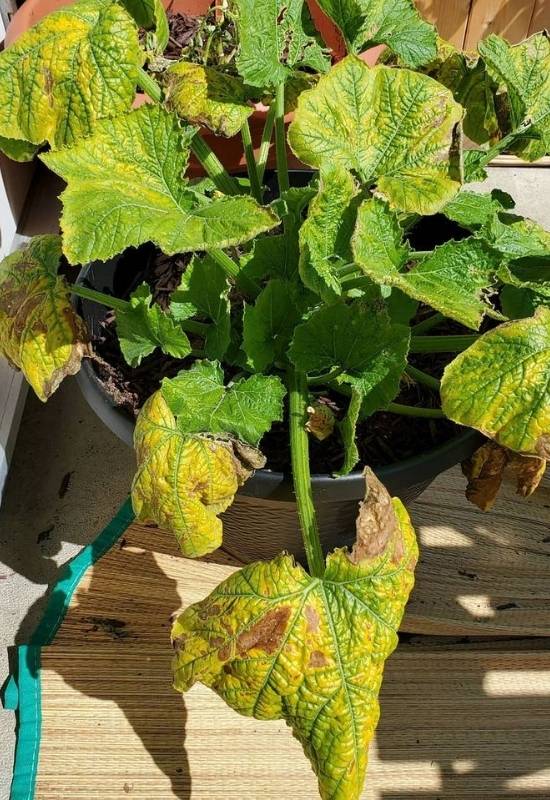
Our mental image of a lush green garden is often tainted in reality by sickly, yellowing leaves. No matter the issue you are dealing with, I hope this article helps you identify and correct the problem so you can get back to enjoying the beauty of your garden, and the bounty that it produces.

Written By
Amber Noyes
Amber Noyes was born and raised in a suburban California town, San Mateo. She holds a master’s degree in horticulture from the University of California as well as a BS in Biology from the University of San Francisco. With experience working on an organic farm, water conservation research, farmers’ markets, and plant nursery, she understands what makes plants thrive and how we can better understand the connection between microclimate and plant health. When she’s not on the land, Amber loves informing people of new ideas/things related to gardening, especially organic gardening, houseplants, and growing plants in a small space.

thank you this helped me a lot!
Thank you for your help but now I have to do the hard work to fix the problem
Thank you! I have always wondered why I couldn’t grow nice zuchinnis and I think that this article will help.
Thanks for the information. Your article is the best I have found since it clearly describes the problem and then gives very good advice.
Learned so much from this article. This is my first garden and just realized that it’s not that easy
Thanks for the info
TY lots of good info that is easy to understand and options
ah, composted horse manure, got plenty of that! check the dampnes of my pot’s soil, and go dig up a shovelful. done.